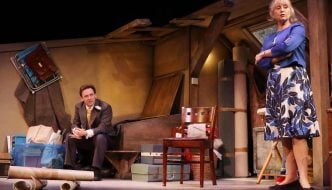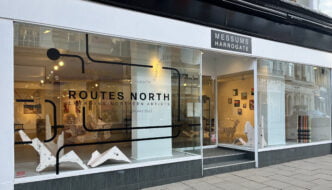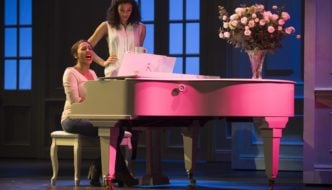Review: The Feast Wagon at The Tetley
January 21, 2016
![[Photo Courtesy http://thetetley.org/feast-wagon/]](https://www.thestateofthearts.co.uk/wp-content/uploads/2016/01/Feast-wagon-3.jpg)
The Tetley has been a brilliant recent addition to Leeds ever growing contemporary art scene. From hosting massive events such as The Garden Party last summer, to putting on family workshops, international artist book fairs, and innovative exhibitions, the Tetley provides something for everyone interested in culture. Their next exhibition, Roger Palmer’s Winter Garden, opens this week and will undoubtedly be a must see. In celebration of this, I took a retrospective look back at their last exhibition, The Feast Wagon.
Simeon Barclay, Delaine Le Bas, Lubaina Himid and Susan Walsh have come together to form The Tetley’s latest exhibition, The Feast Wagon. Co-curated by Kerry Harker, Zoë Sawyer and Irfan Shah, the exhibition responds to the work of the latter, focusing on his extensive research into Louis Le Prince (the famed moving image pioneer), and his brother-in-law, John Robinson Whitley (the Yorkshire industrialist, who lived a mere stones throw from The Tetley). Whitley was instrumental in bringing Buffalo Bills Wild West Show to London in 1887; a show which has evidently been integral to the designs and sculptures featured in the exhibition.
What is particularly striking about The Feast Wagon, is the space in which the pieces have been presented. The audience begins their journey outside; where in the garden, laying desolate, is a large scale, ruby wagon, perhaps harking back to the industrial powers that have been its inspiration. As you make your way to the first floor atrium of The Tetley, where the rest of the exhibition is situated, you are instantly greeted by a number of smaller, hand-painted, wooden wagons, bicycles and rocking horses. The wagons are each intricately illustrated with various animals such as wild boars, snakes and beetles, and it is here that you are invited to interact with the pieces, reanimating them however you may wish. These specific sculptures, created by Himid and Walsh, seem to mirror the theme of travel, which similarly enmeshes every piece in this section. The sculptures are placed in a clean, organised circle, counteracting the rough material and subject matter of chaos and movement.
Surrounding the main room are four adjoining, smaller galleries, which continue to explore the themes of space and movement. Various images of migration, as well as the influence and presence of Buffalo Bill, play key roles throughout this part of the show. Wagons are replaced by reading materials, newspaper clippings and imagery relating to the Wild West Show, Queen Victoria and the Royal Family. The images of the Royal Family emphasise both the importance, and the cultural impact that the Wild West Show had in bringing new perceptions on migration and culture to society. Walsh also presents a series of diverse collages, each depicting different scenes of the difficulties caused by migration, using pictures of gypsies and Holocaust victims to illustrate her point. The smaller galleries are connected by walkways inside the room, again referencing the ever-present theme of travel, alongside an exploration into issues of globalisation, the history of touring shows, and the impact upon identity and culture during the late 19th and 20th Centuries.
In the third room, Le Bas tackles the subject of Roma identity. Le Bas has exhibited both internationally and in the UK, and is widely recognised for her exploration into nationhood, isolation and Outsider Art. Le Bas applies these themes, and considers her own Romany background in her work for The Feast Wagon. She uses a variety of materials in her installations, including clothing made from Sex Pistols t-shirts and old polka-dot dresses, numerous Romany artefacts, pot dolls, photographs of young Romany women, musical instruments, and a looping video titled Gypsyland. Le Bas comments upon the suffering and change of Romany culture, providing a contemporary point of view on these age old traditions and identities, and how they have affected the Romany people. She subverts these issues by drawing comparisons with Punk and The Sex Pistols; who too were once on the cusp of society, feared for their anarchy and differences to the norm.
The most intriguing work in the exhibition is provided by Barclay, and his large scale prints and installations. His work evokes masculinity and the struggles with race and identity. The room is separated into three smaller rooms, each adorned with various male centric iconography. From the infamous picture of Vinnie Jones gripping Gascoigne’s crotch on the pitch, to Eric Cantona during his short placement at LUFC, and a small picture book showing a male model in several stages of undress, hidden inside Barclay’s An Arrangement on Grey. However, what is especially interesting to note, is that the male dominance is punctured slightly by the appliance of overtly female imagery, such as stiletto shoes, nail polish and young female models taking selfies. These juxtaposing images could symbolise the friction that the male identity struggles with in contemporary society. Upon entering the final room, you are met by a pre 50 Shades Jamie Dornan, placed on a white background, and overlapped by a black male hand in the shape of a gun, an obvious reference to the recent spate of black gun related deaths. As this is the first image seen in the gallery, Barclay sets an immediate tone for identity in crisis.
Currently in its final days of presentation, The Tetley’s latest show will come to a close on January 10th. A fascinating exhibition, in which each of the artists involved have created an eclectic mix of thought provoking commentary on society, identity, and culture in both the past and present.




Comments